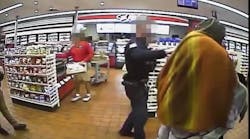TAMPA, Fla. — At 330 pounds and over 6 feet tall, Deputy Ed Aulick was so big and strong he could fight several men at once, according to newspaper stories of the day.
He was nicknamed “The Lone Wolf” by The Tampa Tribune for his propensity to rush into dangerous situations without calling for backup. He carried an ax along with his gun.
The qualities that made Aulick front page news appear to have figured in his killing, too — probably a hit by thugs working for the underworld figures who were Aulick’s targets.
The culprits in that Jan. 24, 1932, attack never were brought to justice.
Nine decades later, today’s law enforcement community and the community at large will honor Aulick and 14 other Hillsborough deputies killed in the line of duty with the dedication of Fallen Heroes Remembrance Park at Eighth Avenue and 19th Street.
A granite wall bearing their names and photos will be unveiled in a ceremony at 7:30 tonight.
Aulick the superhero is the only image remaining of the deputy; few records have been found to describe the man out of uniform.
“He was killed about six months before I was born,” said Aulick’s nephew, 82-year-old John T. Aulick of Spring Hill. “And no one talked about him, so I don’t (know) anything about him other than that he was a deputy.”
As far as John Aulick knows, he is the last of the Aulicks.
According to census records and city directories from the early 1900s, Ed Aulick was born in Florida April 18, 1901, to Charles and Fannie Aulick. He had two younger brothers, Frank and Jack, and a younger sister, Mary.
He married Leona Shaddick in 1920 and spent the next nine years working as a mechanic and carpenter.
On Oct. 4, 1929, Gov. Doyle Carlton named Robert Joughin as Hillsborough County Sheriff. He replaced Luther Hatton, who was suspended after he was accused of taking bribes from members of Tampa’s underworld.
?
Carlton won the 1928 election by promising to end gambling and bootlegging rackets throughout the state.
Newspaper accounts from 1927 documented 300 local illegal gambling parlors in Tampa earning an estimated $20 million that year. Historians say Tampa and Hillsborough County law enforcement would help bootleggers carry their products into Prohibition-era speakeasies.
The governor chose Joughin as his new sheriff for his reputation as hard-nosed and honest.
Aulick was Hatton’s first appointed deputy.
Newspaper accounts over the next few years tell of Aulick singlehandedly raiding moonshine operations. If the moonshiners were not at the distillery when he arrived, he would wait for them to return, still refusing to call for backup.
Aulick was known for shooting moonshine barrels full of holes and destroying equipment with his ax.
He was found slain in a ditch on the corner of 15th Street and 23rd Avenue, in what is now the V.M. Ybor neighborhood.
Six bullets were fired into his body at close range and his head was cut by a powerful blow with blunt instruments. Investigators at the time said there must have been many attackers because no one man could have bested Aulick.
Aulick’s wife reported they had received anonymous threatening phone calls in the days before the slaying.
He was killed only blocks from his house. His car was found parked, across the street from the ditch, with its engine still running. That led investigators to surmise that he knew who was after him and was waiting for them to drive by his home so he could confront them as he did every threat — alone.
Others thought Aulick was killed in retaliation for his investigation of arsonists burning buildings they owned to collect the insurance money.
In February 1932, numbers runner Roland “Cowboy” Hernandez asked the sheriff’s office to lock him in a cell to protect him from the same men who killed Aulick.
?
Hernandez would name no names. That night, he was found hanged in his cell.
In 1933, reputed underworld figure Augustine Friscia admitted to the arson Aulick was investigating, but Friscia was never questioned in the slaying.
In 1948, Raymond Thompson, 45, was arrested and charged with Aulick’s murder. Thompson’s wife turned him in, claiming he did it out of spite for when he was arrested by Aulick for bootlegging.
Thompson was acquitted, though. The court ruled his wife lied to spite him during a nasty divorce.
“Every so often another suspect would be named, but it was always during an election season,” nephew John Aulick said.
“Just politicians pretending they could clean up the city who wanted to pretend to solve the unsolved murder. But it’s never been solved and at this point it never will.”
Copyright 2014 the Tampa Tribune (Tampa, Fla.)
McClatchy-Tribune News Service


